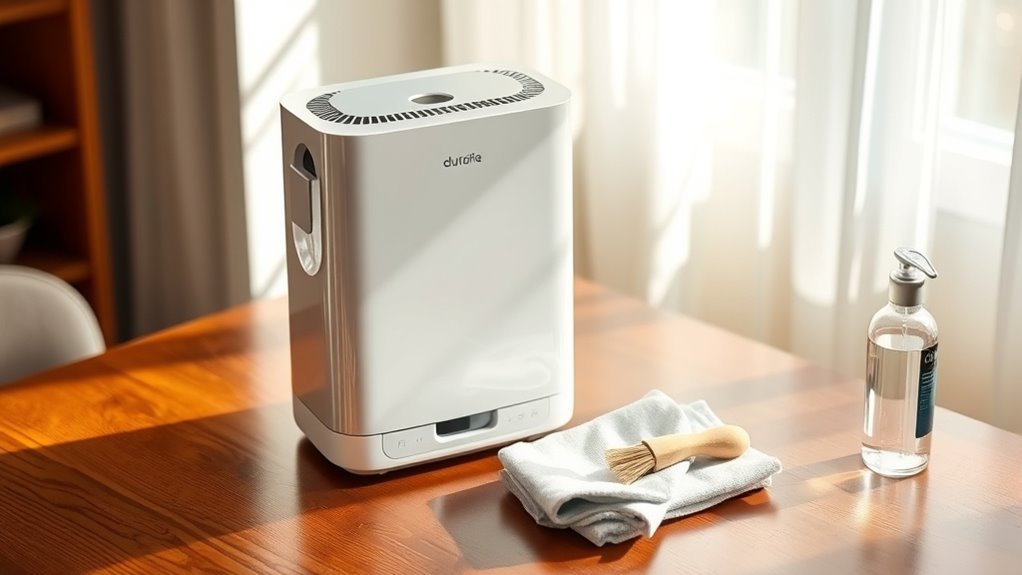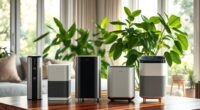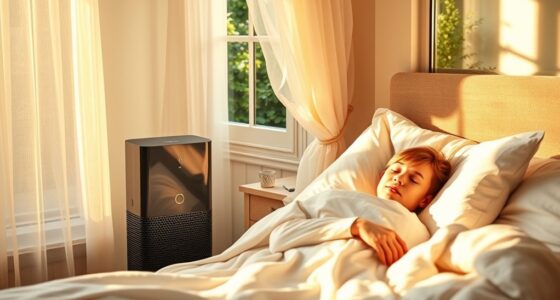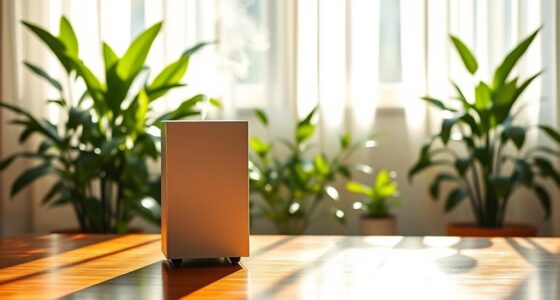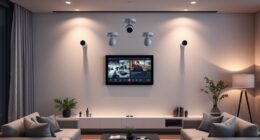To properly maintain and clean your air purifier, start by inspecting and cleaning the HEPA filter every 1 to 3 months. Replace disposable filters every 6 to 12 months and activated carbon filters every 3 to 6 months. Wipe down the exterior every 2-4 weeks and disinfect the interior using a bleach solution. Keep an eye on filter indicators and address any unusual noises or odors promptly. Discover more essential tips to guarantee your air purifier’s efficiency and longevity.
Key Takeaways
- Regularly clean or replace HEPA filters every 1 to 18 months, depending on usage, to maintain air quality and efficiency.
- Wipe down the exterior surfaces of the air purifier every 2-4 weeks with a microfiber cloth to remove dust and dirt.
- Check the air filter indicator light and log replacement dates to ensure timely maintenance and optimal performance.
- Unplug the unit before cleaning and use a mild detergent solution for disinfecting the interior and exterior surfaces.
- Monitor for unusual noises or decreased airflow, and troubleshoot by cleaning or replacing filters as needed.
Importance of Regular Maintenance
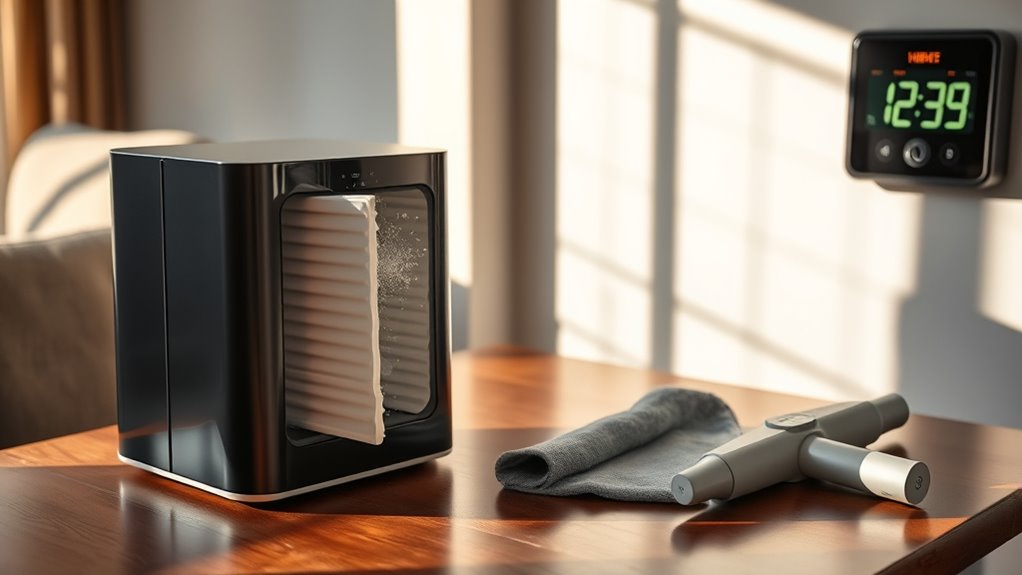
While it might be easy to overlook, regular maintenance of your air purifier is essential for keeping your indoor air clean and healthy. By staying on top of air purifier maintenance, you assure peak performance and efficiency.
Neglecting filter changes—like carbon filters every 3-6 months and HEPA filters every 12-18 months—can greatly reduce your unit’s ability to capture allergens and pollutants, ultimately affecting indoor air quality. Regular cleaning processes vary by model, and knowing them can help you maintain your purifier effectively. Additionally, using models with HEPA filters can significantly enhance the filtration of airborne particles, ensuring cleaner air. Routine maintenance also contributes to optimal performance by allowing your purifier to function at its best.
Regular cleaning and maintenance, including disinfecting the interior every few months, help prevent mold and bacteria buildup, which can be exacerbated by humidity levels in the environment. Plus, monitoring filter indicators allows you to extend your air purifier’s life, reduce waste, and save money. Additionally, ensuring proper airflow around the unit enhances performance and efficiency.
Prioritizing these tasks guarantees you breathe clean air and enjoy a healthier living environment.
Cleaning a HEPA Filter
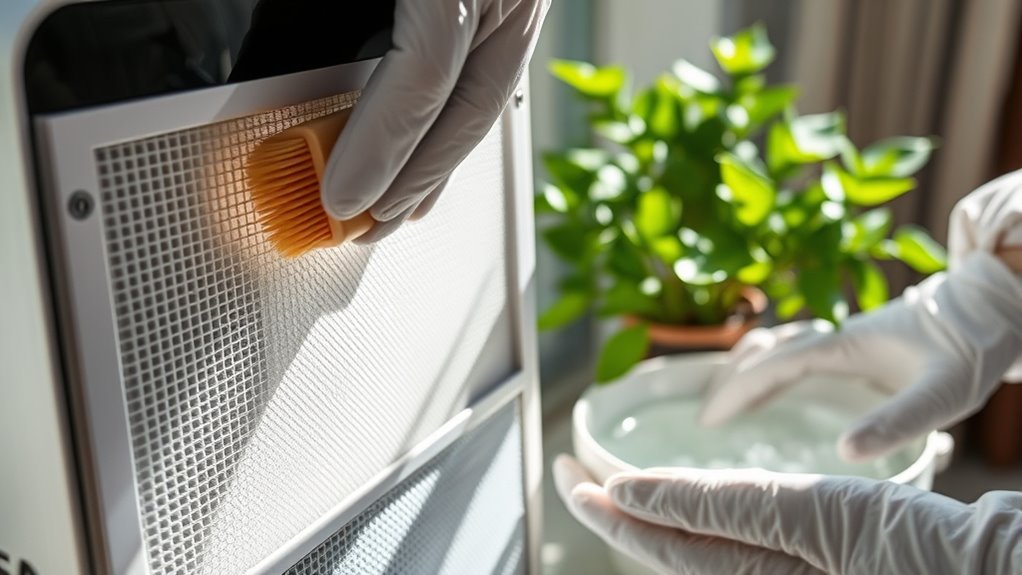
To keep your HEPA filter working effectively, you should clean it every 1 to 3 months, depending on how often you use your air purifier. Regular cleaning helps maintain its ability to remove 99.97% of airborne pollutants, ensuring that your indoor air remains fresh and healthy. Additionally, using a high-quality true HEPA filter can further enhance the efficiency of your air purifier. Heat pumps, for instance, can also contribute to better indoor air quality by reducing energy consumption in homes, leading to fewer emissions. Moreover, maintaining clean air indoors can help reduce skin cancer risk by minimizing exposure to pollutants that may affect overall health.
When cleaning, gently vacuum the surface and use a soft brush to remove any stubborn dirt. Remember to avoid harsh chemicals, as they can damage the filter. Regular maintenance is essential for ensuring optimal indoor air quality, as neglected filters can lead to decreased performance and increased allergens.
Cleaning Frequency Recommendations
Inspecting your HEPA filter every month is essential for maintaining your air purifier’s efficiency.
To guarantee your air filters function at their best, follow these cleaning frequency recommendations:
- Inspect Monthly: Check for visible dirt and debris to decide if it needs cleaning or replacement.
- Clean Every 3 to 6 Months: If your HEPA filter is washable, clean it regularly, depending on your environment’s dust levels. Regular cleaning can help reduce allergens that may circulate in your home. Additionally, using an air purifier can enhance your home security systems, providing a safer living environment.
- Replace Non-Washable Filters: Generally, replace these filters every 12 to 18 months, following the manufacturer’s instructions.
Additionally, incorporating regular maintenance into your routine can significantly improve the overall performance and lifespan of your air purifier.
Proper Cleaning Techniques
Maintaining your air purifier goes beyond simply checking the filters; knowing how to clean them properly is key to ensuring peak performance.
Start by unplugging the air purifier to avoid any electrical hazards. Inspect the HEPA filter monthly for dirt and debris. Engaging in this routine promotes mindfulness and presence, enhancing your overall indoor environment. Regular maintenance also aligns with planning interior design principles, as a clean air purifier contributes to a healthier space. Additionally, ensuring your air purifier operates effectively can help mitigate common causes of indoor air quality issues. A well-maintained air purifier can also complement your efforts in regular cleaning routines.
To clean a HEPA filter, gently vacuum its surface with a soft brush attachment to remove loose particles. If the manufacturer’s instructions allow, wash the filter with warm water and mild detergent, ensuring it’s thoroughly rinsed and dried before reinstalling.
If you notice persistent dirt or reduced airflow after cleaning, it’s time to replace the filter, as non-washable HEPA filters shouldn’t be cleaned. Additionally, maintaining color accuracy in your air purifier’s performance can enhance indoor air quality.
Following these steps will help maintain peak performance of your air purifiers.
Maintaining a Disposable Filter

To keep your air purifier running efficiently, you’ll need to stay on top of the filter replacement schedule, usually every 6 to 12 months. Before replacing the disposable filter, clean the air outlet to guarantee ideal airflow. Regularly replacing filters can significantly improve your air quality throughout your home. Additionally, maintaining proper airflow with devices like ceiling fans can enhance overall comfort and efficiency. Remember to use manufacturer-approved filters for the best performance. Regular maintenance tips for paint sprayers can also help you understand the importance of timely replacements for optimal device functionality.
Filter Replacement Schedule
A regular filter replacement schedule is essential for guaranteeing your air purifier operates at its best.
To maintain peak air quality, follow these guidelines:
- Replace your disposable air filter every 6 to 12 months, depending on usage and the manufacturer’s recommendations.
- Change activated carbon filters every 3 to 6 months to prevent saturation and guarantee efficient odor absorption.
- Monitor for signs of replacement: look for dirt buildup, decreased airflow, or a lit filter indicator.
Cleaning Procedure Overview
After you’ve established a filter replacement routine, keeping your air purifier clean is the next step in maintaining its efficiency.
Start by turning off and unplugging the unit for safety. Follow the manufacturer’s instructions to remove the front grill, and if needed, wash it with soap and water.
Next, locate the disposable air filter and carefully remove it. Replace it with a manufacturer-approved filter designed for your model to guarantee peak air cleaning performance.
Don’t forget to use a soft-bristled brush to clean the filtered air outlet, removing any dust and debris.
Finally, reattach the front grill and wipe down the exterior with a microfiber cloth to keep it clean and free from fingerprints.
Monitoring Filter Replacement

How often should you check your air purifier’s filter? Regular monitoring is essential for maintaining peak performance. Here are a few tips to help you stay on track:
- Check the air filter indicator light: This light usually signals when filters need replacement every 6 to 12 months, based on usage.
- Keep a log of filter replacement dates: Tracking these dates prevents reduced efficiency due to clogged filters.
- Consider environmental factors: If you have pets or smoke indoors, you may need to replace activated carbon filters every 3 to 6 months, while HEPA filters generally last 12 to 18 months.
Always consult the manufacturer’s recommendations for specific guidelines tailored to your air purifier model.
Cleaning the Air Purifier Exterior
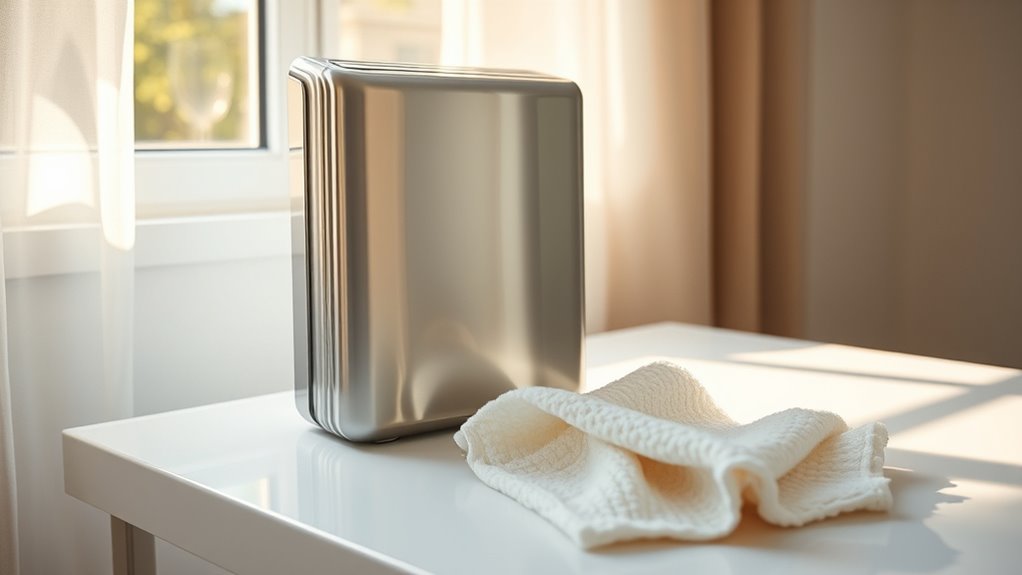
Keeping your air purifier clean isn’t just about the filters; the exterior needs attention, too.
To maintain its appearance and functionality, wipe down the exterior surfaces every 2-4 weeks using a microfiber cloth to remove dust and dirt buildup. For a deeper clean, use a damp cloth with mild detergent while avoiding moisture in any openings or vents.
If you encounter stubborn dirt, a soft-bristled brush can help remove debris without scratching the surface. Always remember to unplug the unit and let it cool down before cleaning.
After you’ve finished, dry completely with a microfiber towel to prevent moisture accumulation and potential mold growth. Regular cleaning can help prolong your air purifier’s life and efficiency.
Disinfecting the Interior
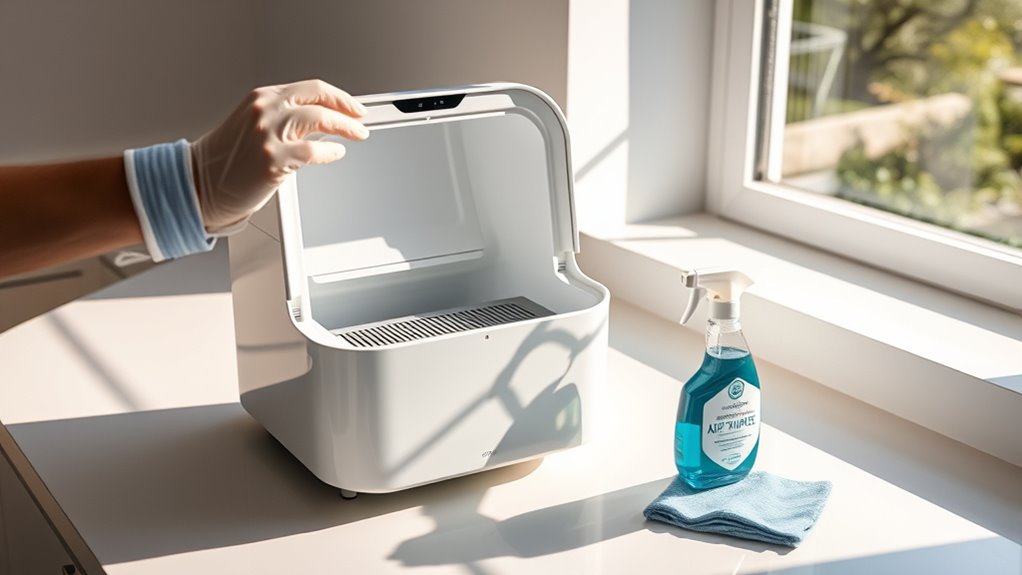
Disinfecting the interior of your air purifier is essential for maintaining ideal air quality.
Regularly addressing mold and bacteria can prevent health issues and improve efficiency. Here’s how to do it:
- Unplug the air purifier and remove the filters to guarantee safety.
- Use a bleach and water solution (1:1 ratio) or a mold removal cleaner to disinfect the interior surfaces, focusing on corners and crevices.
- Scrub any visible contaminants with a soft cloth or cleaning brush, then allow all surfaces to dry completely to avoid moisture buildup.
Incorporate this disinfecting step into your maintenance routine every 3–6 months.
Doing so helps guarantee your air purifier continues to function at its best and keeps harmful microbes at bay.
Troubleshooting Common Issues

Is your air purifier not performing as expected? First, check if it’s plugged in and powered on—this common oversight can halt everything.
Is your air purifier underperforming? Start by ensuring it’s plugged in and switched on—this simple check can make all the difference.
If you see a red filter light, it’s time to replace the filter, so consult the manual for your model’s specifics.
Unusual noises may signal a need for troubleshooting; verify the unit is on a stable surface and clear of obstructions.
Decreased airflow often means you’re dealing with dirty filters, so clean or replace them regularly to combat air pollutants effectively.
If you notice persistent odors, it might be time to clean the interior, replace the carbon filter, or remove pet hair that could be causing issues.
Following the manufacturer’s instructions is essential for peak performance.
Frequently Asked Questions
How to Properly Clean an Air Purifier?
To properly clean your air purifier, start by turning it off and unplugging it for safety.
If it has a washable HEPA filter, rinse it with warm water, ensuring it dries completely.
Use a microfiber cloth to wipe the exterior, avoiding moisture in vents.
Regularly brush the air outlet and front grill to remove dust.
If your purifier uses UV lamps, dispose of them responsibly as they contain mercury and require special handling.
What Maintenance Does an Air Purifier Need?
Imagine breathing in crisp, fresh air, free from dust and allergens.
To keep your air purifier working its magic, you’ll need to perform regular maintenance. Change or clean filters as needed—disposable ones every 6-12 months and washable ones every 3 months.
Wipe down the exterior every few weeks and disinfect the interior every 3-6 months.
Finally, verify there’s unobstructed airflow by positioning it away from walls and heavy furniture for peak performance.
Are You Supposed to Leave Your Air Purifier on All the Time?
Yes, you’re supposed to leave your air purifier on all the time for the best air quality.
Continuous operation helps it effectively remove pollutants and allergens, especially in high-traffic areas.
Many models are built for this, with sensors that adjust fan speeds based on air quality.
While you can turn it off occasionally, doing so may let airborne particles accumulate, which isn’t ideal if you have pets or smoke in your home.
How Can I Make My Air Purifier Last Longer?
To make your air purifier last longer, you should regularly replace or clean the filters as recommended, typically every 6-12 months.
Keep it a few inches away from walls and furniture to maintain proper airflow.
Clean the exterior every 2-4 weeks with a microfiber cloth and mild detergent.
Finally, follow the manufacturer’s maintenance guidelines and utilize their support resources to troubleshoot issues instead of replacing your unit unnecessarily.
Conclusion
By regularly maintaining and cleaning your air purifier, you not only extend its lifespan but also guarantee that it functions effectively. Did you know that a well-maintained air purifier can reduce indoor air pollutants by up to 99%? Staying on top of filter replacements and cleaning routines is essential for achieving the best air quality. So, make it a habit to check and clean your device, and breathe easier knowing you’re taking care of your home’s air.
